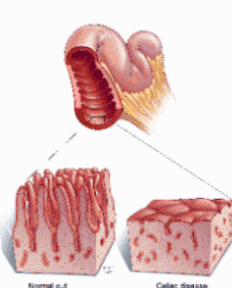CIDPUSA.org Autoimmune diseases
return to page -1
Celiac disease: When the body goes against the grain
Celiac comes from the Latin word abdomen, but this digestive disease can cause symptoms throughout the body. Celiac Disease:

Who should be tested?
People with recurring, unexplained gastrointestinal symptoms such as pain, bloating, or diarrhea should consider testing for celiac disease. Iron-deficiency anemia or high levels of certain liver enzymes (transaminases) should raise a red flag, as should unexplained, recurrent miscarriages and infertility.
Women who develop osteoporosis early (before menopause) or whose osteoporosis suddenly worsens should also consider the possibility of celiac disease. One small study reported a 17-fold higher incidence of the disease among women with osteoporosis compared to women in the general population. Some doctors recommend that parents, siblings, and children of people with celiac disease undergo testing because 5%-15% of first-degree relatives of an affected person are likely to have the disease, too.
Treatment: Avoid gluten
The good news is that the only treatment for celiac disease -- a gluten-free diet --starts to work within days, and the small intestine usually heals completely within three to six months. Although giving up favorite foods such as wheat breads and pizza can be tough at first, many people who have adapted to a gluten-free diet comment that while it can be inconvenient, it does not prevent them from socializing or traveling. Many gluten-free foods are available by mail order and on the Internet, and gluten-free items are becoming more common in supermarkets and restaurants.
Recent developments are making shopping a bit easier, too. As of January 2006, new FDA rules require that all foods containing any of the eight major food allergens (milk, eggs, fish, shellfish, tree nuts, peanuts, wheat, and soybeans) must list that information on their labels. This doesn't mean that people with celiac disease are home free, because even wheat-free products can still cause trouble. For example, while oats don't contain the gluten that harms people with celiac disease, there is the possibility of cross-contamination with wheat in the growing and milling process. Also, some products labeled "wheat-free" contain barley, usually in the form of malt or malt syrup. The FDA is working on a rule for gluten-free labeling with action expected sometime after 2007.
There are general guidelines you can follow (see table below), but you'll need to check labels carefully for hidden gluten in commercially prepared foods, such as cured pork products, self-basting turkeys, imitation meats and seafood, and the thickeners found in gravy and some spaghetti sauces. Another source of hidden gluten is dates and candies that are dusted with flour to prevent sticking.